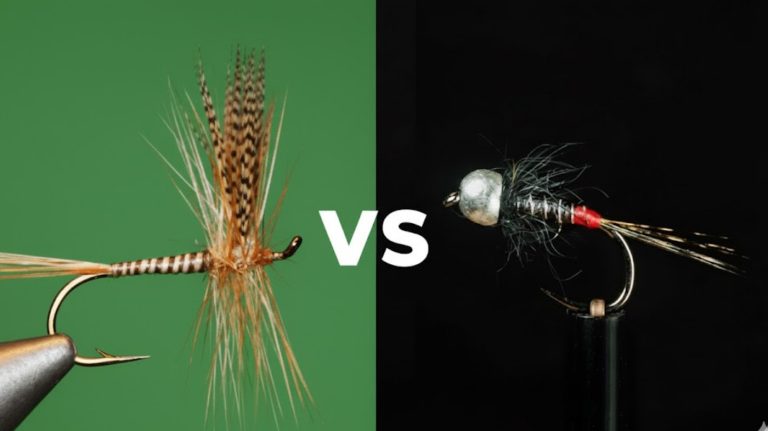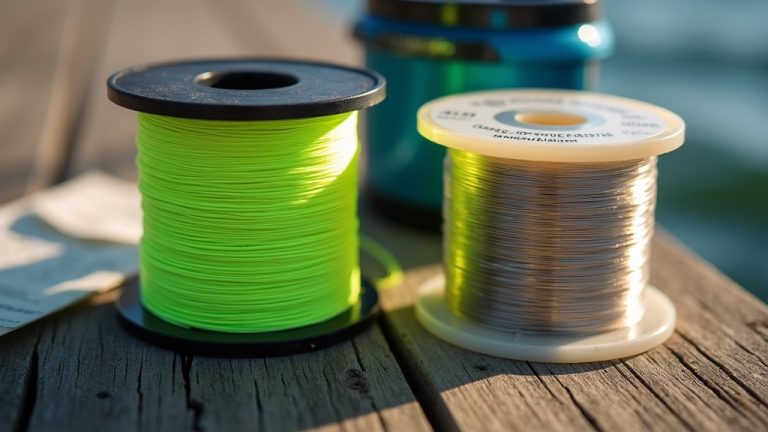Difference Between Male and Female Bass: Key Traits
You’ll find male and female bass differ in growth rates, morphology, and muscle quality linked to reproduction. Females outgrow males after age two and live longer, with softer, rounded jaws and higher fat content in their flesh.
Males have squarer heads, stronger jaws, and faster-twitch muscle fibers for power. Behaviorally, males guard nests while females lay eggs and retreat.
Understanding these distinctions reveals how sex influences bass biology and ecology, offering deeper insights into their life history.
Key Takeaways
- Males have more pointed, triangular jaws with broader, squarer heads; females have broader, rounded jaws and softer head contours.
- Females grow larger and live longer, often reaching 243-292 mm earlier and living up to 16 years.
- During spawning, males display concave bellies and defend nests aggressively; females have fuller bellies and deposit eggs in multiple nests.
- Male vents are circular and near the tail; female vents are oval-shaped and closer to the anal fin.
- Muscle composition differs: females have more slow oxidative fibers for tenderness, males have fast-twitch fibers for firmness and speed.
Quick Comparison Table of Male vs Female Bass Traits
| Category | Female Bass | Male Bass |
|---|---|---|
| Body Size & Growth | Grow larger and live longer; outpace males after age two | Initially grow faster but remain smaller in adulthood |
| Jaw & Head Shape | Rounded jaws and softer contours; narrower head | Pointed, triangular jaw; squarer, broader head |
| Muscle Composition | More slow oxidative fibers for endurance and tenderness | More fast-twitch fibers for speed and firmness |
| Fat & Lipid Content | Higher lipid accumulation for richer flavor and deeper color | Leaner meat with less fat and firmer texture |
| Ventral Features | Oval vent near anal fin; fuller belly, especially during spawning | Circular vent near tail; concave belly during spawn |
| Behavior During Spawning | Deposit eggs across multiple nests, then retreat | Guard nests and defend territory aggressively |
| Lifespan | Can live up to 16 years | Typically have shorter lifespan |
| Hormonal Influence | Higher estrogen levels promote lipid storage and tenderness | Elevated testosterone leads to leaner muscle structure |
| Coloration | Slightly lighter with subtle patterns | Darker, more vivid coloration during breeding |
| Ecological Role | Focus on reproduction and energy storage | Focus on nest defense and offspring protection |
Growth Patterns and Lifespan Variations
Although male largemouth bass initially grow faster during their first year, females consistently outpace males in size from age two onward. This reflects distinct sexual dimorphism in growth patterns. Proper care and cleaning of fishing gear, such as felt-soled shoes, help maintain optimal fishing conditions and reduce environmental impact by preventing the spread of invasive species through basic cleaning methods.
Male largemouth bass grow quickly early on, but females surpass them in size after age two.
You’ll observe females reaching total lengths between 243 and 292 mm earlier than males across multiple populations, including Florida largemouth bass and their northern subspecies. The study conducted across five lakes in north-central Florida highlights these growth differences by back-calculating lengths from otolith annuli, providing detailed age-specific data on size disparities sex-based growth differences.
This size advantage persists through ages one to six, driven by females’ enhanced energy allocation for reproduction. Females also tend to live longer, sometimes up to 16 years, enabling continued growth beyond males’ typical lifespan.
These divergent growth trajectories result from hormonal and reproductive differences, with females prioritizing somatic growth to support fecundity.
When analyzing largemouth bass populations, accounting for sex-specific growth and lifespan variations is vital for accurate assessments and effective fisheries management.
Muscle Composition and Meat Quality Differences
Did you know that female bass muscles actually have higher lipid levels? This is largely due to their reproductive cycles, which play a significant role in how fat is deposited and how the muscle fibers are structured. Females also show an up-regulation of the lipid metabolism gene lpl, which promotes this increased lipid accumulation.
On the flip side, male bass have denser muscle fibers. These fibers have distinct contractile properties that can really affect the texture and overall quality of the meat.
Lipid Content Variation
Female largemouth bass exhibit markedly higher muscle lipid content due to upregulated lipid metabolism genes like *lpl*. This increased lipid accumulation results in greater fillet yield, deeper meat color, and lower muscle fiber density compared to males.
Additionally, the muscle-to-body weight ratio and fat content are optimized around certain body sizes, enhancing the nutritional value of female bass muscle muscle-to-body weight ratio. These physiological differences can be analogized to specialized adaptations seen in species with optimized frame materials for performance and durability.
Lipid variations also influence texture, with females showing higher shear force despite looser fibers, linked to lipid presence and cytoskeletal differences.
Female bass muscle contains higher saturated and certain unsaturated fatty acids, enhancing flavor and juiciness. Seasonal lipid fluctuations are wider in females, affecting nutritional quality.
Male bass display distinct fatty acid profiles correlating with immune gene expression rather than lipid metabolism, similar to how different lens technologies target specific visual needs.
Muscle Fiber Characteristics
Because muscle fiber composition directly affects both functional performance and meat quality, examining the differences between male and female bass reveals key insights.
Females possess a higher proportion of slow oxidative fibers (Type I and IIA), enhancing endurance and meat tenderness. This muscle composition can influence how bass perform in different environmental conditions, similar to how material stiffness affects fishing line performance.
Males have more fast-twitch fibers (Type IIB and IIX) with larger cross-sectional areas, boosting contraction speed and power.
You’ll notice males’ muscle fibers contract faster due to greater Type II content and size, whereas females’ fibers support fatigue resistance.
These fiber distributions affect meat quality: females’ oxidative fibers yield darker, more tender meat with better water retention. Males’ glycolytic fibers produce paler, firmer meat with quicker pH decline.
Reproductive Influence Effects
Although reproductive hormones primarily regulate breeding functions, they also considerably influence muscle composition and meat quality in bass.
Female bass experience cyclic vitellogenin fluctuations that modulate protein metabolism, promoting muscle growth and increased lipid deposition. These hormonal variations can be compared to how lens technology in fishing sunglasses enhances visual performance by adapting to environmental conditions.
Testosterone and estradiol levels differ by sex, affecting muscle fiber arrangement and fat content.
These hormonal effects result in sexually dimorphic muscle traits: females develop looser yet shear-force resistant muscle with enhanced fibrous actin, while males have denser, leaner muscle. It is important to note that in many animal species, males often produce leaner meat due to higher testosterone levels, which can affect flavor and texture gender-specific characteristics.
You’ll notice female bass meat shows deeper color and richer fatty acid profiles, improving flavor and texture.
Key reproductive influence effects include:
- Hormonal regulation altering muscle contraction gene expression and meat firmness
- Enhanced amino acid and lipid profiles in females favoring muscle growth and fat storage
- Differential shear force resistance linked to muscle cytoskeletal composition and fiber density
Physical Characteristics and Morphological Traits
When you take a closer look at bass, you’ll notice some interesting differences between the males and females. For instance, males tend to have a more pronounced jawline that extends beyond their eyes, while females usually have a subtler jaw profile.
It’s also worth paying attention to the placement of the vent and the shape of the belly. Males typically have their vents situated closer to the tail, and during spawning, they display a concave belly. Additionally, males often have longer, more pointed fins compared to females.
On the other hand, females have vents located near the anal fin and boast a fuller, rounder belly.
Jaw and Head Shape
While examining bass morphology, you’ll notice distinct differences in jaw and head shape between males and females that influence their physical profiles.
Male bass possess more pointed, triangular lower jaws with larger, thicker jawbones, creating a broader, squarer head.
Females feature broader, rounded jaws with narrower heads and softer contours.
Males exhibit stronger masseter muscles and thicker skin, accentuating angularity, whereas females show smoother, less defined jawlines due to thinner skin and reduced muscle mass.
Male jawbones align closely with cheekbone width, producing a robust lower face.
This bone structure difference significantly contributes to the overall masculine and feminine appearance in bass.
Females have more tapered, delicate head shapes with less projection.
Chin height and width are considerably greater in males, reflecting stronger mandibular structure.
These structural and soft tissue differences yield pronounced sexual dimorphism in bass head morphology.
Vent and Belly Differences
Beyond jaw and head morphology, vent and belly characteristics offer reliable markers for distinguishing male and female bass.
You’ll note female bass have vents positioned closer to the anal fin with an oval shape, while males’ vents sit nearer the tail and appear circular. Using morphological traits for identification helps anglers improve accuracy in the field.
Females display fuller, rounder bellies, especially during spawning, contrasting with males’ slender profiles.
These morphological traits remain consistent even outside spawning season, aiding accurate sex identification. Additionally, female bass tend to have shorter, less pointed fins, which further assists in differentiating them from males.
| Trait | Female Bass | Male Bass |
|---|---|---|
| Vent Position | Near anal fin | Near tail |
| Vent Shape | Oval/Elliptical | Circular |
| Belly Morphology | Rounded, fuller during spawn | Slender, less pronounced belly |
Combining vent shape and belly size enhances confidence in sex differentiation.
Behavioral Distinctions During Spawning Season
Although both male and female bass engage in spawning activities, their behaviors during the season differ markedly in terms of nest preparation, territoriality, and parental investment.
Male and female bass show distinct spawning behaviors, differing in nest care, territory defense, and parental roles.
You’ll observe males selecting and fanning nests in shallow, protected areas, aggressively defending them for weeks post-spawning. Females, conversely, deposit eggs across multiple nests, then promptly retreat to deeper water, showing minimal parental care. Water temperature plays a crucial role in triggering these spawning behaviors, typically occurring when temperatures reach the low 60s. Seasonal changes in fish habitat also influence spawning success and behavior patterns.
Key behavioral distinctions during spawning include:
Males maintain high territorial aggression around nests, enhancing egg survival through continuous guarding. Females distribute reproductive effort by spawning multiple times and spreading eggs over various nests.
Males remain highly visible and active near nests, while females reduce visibility by retreating swiftly post-spawn.
Methods for Identifying Male and Female Bass
When identifying male and female bass, you must rely on distinct morphological and anatomical features that differ between the sexes.
Externally, males exhibit a pronounced, robust jaw extending beyond the eye, darker, more vivid flank coloration, and longer, pointed dorsal and anal fins. Males also tend to have rougher scales compared to females. Selecting the right footwear and clothing can similarly enhance your outdoor experience when fishing for bass.
Females typically have a rounded jawline, lighter coloration, shorter fins, and larger body size. The vent position is a critical indicator: males’ vents lie closer to the tail, while females’ vents are adjacent to the anal fin.
Females exhibit two openings versus one in males. During spawning, males show a concave belly, contrasting with females’ swollen abdomen.
For definitive identification, laboratory gonad extraction and microscopic examination reveal pale testicular tissue in males and reddish ovarian tissue in females, ensuring 100% accuracy.
Comparative Analysis of Sexual Dimorphism in Fish Species
Identifying male and female bass through morphological and anatomical traits sets the stage for a broader examination of sexual dimorphism across fish species.
You’ll find that sexual size dimorphism (SSD) varies widely: females often outgrow males in species like European sea bass, while in Nile tilapia, males grow faster. Recent research using comparative RNA-seq analysis has revealed common regulatory mechanisms underlying sex-based growth differences across species by analyzing brain and muscle tissues. Additionally, environmental factors such as habitat complexity and resource availability can influence the degree of SSD observed in urban and natural ecosystems.
Molecular mechanisms underpin these differences, with sex-specific gene expression influencing growth and metabolism in largemouth bass.
Behaviorally, males typically engage in nest building and parental care, while females focus on foraging and egg deposition, reflecting ecological niche partitioning. Such behavioral distinctions also affect habitat use patterns, often leading to males occupying and defending prime cover structures favored in urban fishing environments.
Female-biased SSD is prevalent but species-specific SSD variations exist.
Genetic pathways like AMPK signaling drive sex-based growth differences.
Behavioral roles align with metabolic and habitat use disparities between sexes.
This comparative analysis reveals complexity in sexual dimorphism across fish taxa.
Frequently Asked Questions
How Do Environmental Factors Affect Male and Female Bass Growth Rates?
You’ll find that environmental factors influence male and female bass growth rates primarily through indirect mechanisms like spawning success, juvenile survival, and habitat quality.
Temperature, water levels, and nutrient availability impact overall population growth rather than causing sex-specific effects.
Changes in substrate and waterbody characteristics affect resource availability and competition, similarly shaping growth patterns within size classes regardless of sex.
What Is the Impact of Diet on Bass Muscle Quality by Sex?
Diet markedly shapes bass muscle quality differently by sex. You’ll find that formulated diets upregulate lipid metabolism genes in females, boosting muscle lipid content and fillet yield.
In contrast, males increase immune-related and amino acid metabolism genes, enhancing muscle protein quality and immune competence.
Dietary protein and fat levels modulate muscle fiber structure, texture, and amino acid profiles, resulting in sex-specific variations in muscle density, shear force, and nutritional value.
This information guides targeted feeding strategies.
Are There Differences in Bass Immune Responses Between Males and Females?
You’ll find that male bass exhibit changes in over 2,600 immune-related genes post-infection, whereas females show alterations in just about 100. This indicates males mount a more direct immune activation.
In contrast, females regulate immune gene expression to protect reproductive tissues.
Hormonal influences, like androgens suppressing immunity in males and estrogens modulating female responses, further drive these sex-specific immune strategies in bass.
How Does Fishing Pressure Influence the Population Sex Ratio in Bass?
Fishing pressure skews bass population sex ratios by disproportionately removing larger males, reducing male abundance.
This selective harvest lowers fertilization rates and prompts females to accelerate sex change to males, attempting to compensate.
However, excessive male depletion disrupts natural mating dynamics, reduces recruitment, and may trigger fisheries-induced evolutionary shifts.
You need to contemplate these impacts to effectively manage bass populations and maintain reproductive balance under fishing stress.
What Genetic Markers Distinguish Male Bass From Female Bass?
Imagine a hidden genetic barcode that sets males apart from females in largemouth bass. You’ll find a ~51-kb male-specific region (MSR) on chromosome 10 harboring the msy gene, along with sex-associated SNPs clustered in a 3.5-Mb sex-determination region.
Males are heterozygous at these loci, while females are homozygous.
Additionally, genes like ccdc103 and jockey contribute to male determination, and male-specific non-coding sequences serve as definitive sex markers.
Understanding the Difference Between Male and Female Bass Matters
When you plunge into the world of bass, understanding the subtle currents of difference between males and females sharpens your insight.
Their growth patterns, muscle makeup, and spawning behaviors form a complex mosaic, revealing nature’s precise design.
By mastering these distinctions, you not only decode their biological blueprint but also enhance your ability to identify and study them with scientific accuracy. Let these details guide you through the intricate dance of sexual dimorphism in bass.







